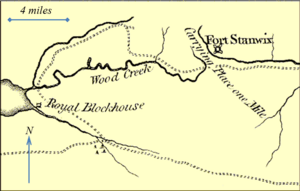Oneida Carry facts for kids
The Oneida Carry was a super important path for trade and travel way back in the 1700s. It connected the Atlantic Ocean to the huge lands inside North America. Imagine boats called bateaux carrying goods up the Mohawk River from places like Schenectady, New York near Albany, New York.
When they reached what is now Rome, New York, people had to carry their boats and cargo overland for a few miles. This carrying place was called the Oneida Carry or The Great Carrying Place. The Haudenosaunee people, who lived there, called it De-o-Wain-Sta. After the portage, the boats would go down Wood Creek to Oneida Lake, then the Oswego River, and finally to Lake Ontario at Oswego, New York. Lake Ontario was like a giant doorway to all the other Great Lakes, which stretched for a thousand more miles!
This path was super important because the only other big water route to the continent's inside was the Saint Lawrence River. So, for almost a hundred years, whoever controlled the Oneida Carry controlled the movement of military supplies, trade goods, and everything else. It was a key spot in wars between Britain and France, the American Revolution, and the War of 1812. The city of Rome, New York was even founded there in 1796 because of its importance. Its military value lessened after the Erie Canal was finished in 1825, making it just one of many "ports."
Quick facts for kids
Oneida Carry
|
|
|---|---|
|
Portage
|
|

Map Depicting the Siege of Fort Stanwix and the Oneida Carry
|
|
| Nickname(s):
Deo-Wain-Sta or "The Great Carrying Place"
|
|
| Country | United States |
| State | New York |
| County | Oneida |
| City | City of Rome |
| Elevation | 456 ft (139 m) |
Contents
The Oneida Carry in the American Revolution
After the French and Indian War, the Oneida Carry became a peaceful place. The British left Fort Stanwix around 1774. A family named Roof even opened a tavern there! Merchants still used the carry to move goods, and an important agreement, the Treaty of Fort Stanwix, was signed there in 1768.
However, during the American Revolutionary War, the Oneida Carry became a battlefield again. American soldiers, called Patriots, took control of the carry in August 1776. They worked for a year to rebuild Fort Stanwix.
Siege of Fort Stanwix
In August 1777, the British arrived and tried to take Fort Stanwix. This was called the Siege of Fort Stanwix. The Patriots successfully defended the fort, and after that, there wasn't much fighting at the Oneida Carry.
In 1779, the American army used the fort as a starting point for a mission to destroy a Native American village. In 1780, a large group of Native Americans, led by Joseph Brant, attacked the fort. The Patriot soldiers inside were safe, but the Native Americans, who were helping the British, were not as protected.
Sometimes, small groups of Loyalist raiders would bother the soldiers at the fort. While some soldiers lost their lives in these attacks, most of the time, being stationed at the fort was quite boring. In 1781, floods and a fire destroyed most of the fort, and the American troops left. They came back in 1784 to sign the Second Treaty of Fort Stanwix. This treaty officially ended the American Revolution with the Native Americans who had sided with the British.
The Oneida Carry: 1800s and Beyond

After the war, the Oneida Carry remained important for business. In 1792, a company built a canal connecting the Mohawk River and Wood Creek. This meant boats no longer had to be carried overland! These canals were used until 1817, when the much larger Erie Canal began construction in the new City of Rome.
The carry also stayed important for military purposes. In 1813, the Rome Arsenal was built. This was a large military complex with barracks, workshops, and storage for weapons. It supported American soldiers during the War of 1812, the Mexican–American War, and the American Civil War. This arsenal replaced an earlier one built in the 1790s on the site of the old Fort Stanwix.
In 1941, the military looked for a place to build an Air Depot in central New York. The Oneida Carry was chosen again! Griffiss Air Force Base opened in 1942. It became home to important facilities like the Rome Labs and the Strategic Air Command. Even though the Air Force Base is now closed, it still houses the Northeast Air Defense Sector. This facility helps detect and defend the entire eastern part of the United States.
Today, the city of Rome covers most of what was once the Oneida Carry. In 2010, Rome had about 33,725 people. It is the second largest city in New York State by area.
Images for kids
-
The Mohawk Valley, running east and west, cuts a natural pathway between the Catskill Mountains to the south and the Adirondack Mountains to the north




